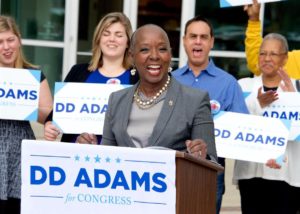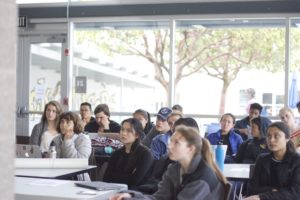A school board’s decisions have major effects on student life. From school funding to development, a school board has the important job of maintaining and shaping the educational experience of students in the long-term. However, despite the key role the board plays, it is often disconnected from the students it serves. Students often wonder what their school board does and how the board can be approached. Without student input, the board might misjudge the student experience. Jacoba Urist, an Atlantic Magazine writer, said, “teenagers deserve a say in policies that affect them.”
Just like schools across the country, Lick seems to have the same issue with the student-school board connection. Often, students question the school board’s purpose, as nobody has communicated the board’s function to them. For example, Meg Wiley ’19 knew only that “they’re Mr. Temple’s bosses and make decisions for the school.” Even though that is somewhat correct, it is extremely vague, which reveals that the Board of Trustees’ purpose is relatively unclear to the student community at Lick. When asked about the school board, an anonymous student’s first response was “who is even on the school board?”
So, who is on the board of Lick-Wilmerding High School, why are they here, and how does their work directly affect Lick students? According to board president Wally MacDermid, the main goal of his and of the board’s is to “create and implement a long-term strategy for Lick-Wilmerding. That strategy drives our work on topics such as managing how the endowment is invested, working with the Finance office to structure annual budgets, working with Facilities to maintain the campus, and working with Development on fundraising.” That goal is the driver for the eight board committees, which include the audit, building, campus stewardship, development, endowment, executive, finance, and governance committees.
According to the Lick-Wilmerding website, the audit committee “makes recommendations to the Board concerning the hiring, retention, and termination of an independent auditor,” while the building committee oversees “all of the planning, review, timelines and approvals of design for the new classroom building.” The campus stewardship committee works in coordination with the endowment and finance committees to review “campus physical plant, capital improvements and planning issues in support of the Chief Financial Officer; and advises on off-campus real property assets.” The development committee “assists in the establishment of all development policies and operating plans, and works with the development office to create short and long-term goals.” The endowment committee “reviews the endowment balance, investment strategy, and performance.” Providing “prudent oversight of the financial operations of the school,” the finance committee reviews “the fiscal impact of proposed new Board initiatives to make recommendations to the Board on financial decisions.” The governance committee has many functions, ranging from designing programs for trustee bonding to identifying the board’s needs as a whole. Leaders of the board, including the president, vice president, and committee chairs, make up the executive committee.
The school board does not just work with Head of School Eric Temple. They are regarded as the “highest-level decision-making authority” at Lick, according to the Lick website. All their decisions and responsibilities heavily affect the school. Consequently, students believe the board should increase their efforts to consult the students themselves— the very people that the board’s actions affect. “They should have more contact with students overall,” said Wiley.
Lick is taking and has taken steps to remediate student-board communication. Board President MacDermid says that “last year, a handful of Lick students joined the board at our annual retreat. The students helped the board understand how they spent time on campus and what areas they liked more than others. Our discussions with the students were the highlight of the day.”
Despite this instance of cooperation, the student community and Board of Trustees are still undoubtedly isolated from each other.
However, Temple said that this is not necessarily a bad thing. The board “thinks on a macro level” and is “not involved in the day to day running of the school,” he explained. The board works on long-term goals, but students are only at Lick for four years, so what the board does is not always fully related to the students. Nevertheless, Temple said that “for the board to understand the student experience is really important,” but he insisted that, “it is my role as the chief conduit between the school and board to actually supply the board with data and exposure to the student experience.” Temple is the liaison between students and the board, so even when the board does need input from students, he said that they do not really need to work directly with the students themselves.
Even though the board might work more in the background, students still want to know more about what they are working on and who they are. “The school board needs to make themselves known to us. I want to know more about them,” Wiley said. The same goes for MacDermid, as he wants to “involve students directly in some of our meetings and activities.” So, this feeling between students and the board is mutual. They both want to deepen their connections and relationships with each other, and now the only problem is to figure out how that can be done.
According to both MacDermid and Temple, a solution to the student- board connection are the children of board parents, who offer input and opinions. Temple says “one-third of the board are current parents of the school. They are bringing the experience of their children and children’s friends into the room.” Similarly, MacDermid believes board parents “bring good insights to our board work based on what we hear from our children.”
However, when told who was on the school board, many students have said anonymously that board parents’ children and their friends do not properly represent the full student body, especially in terms of socioeconomic diversity.
Another way that the board already properly understands student needs has been in place for a while. MacDermid says the “board pays close attention to the Perception and Satisfaction Survey that the community completes every two years. As part of the strategic planning process, Mr. Temple’s team will share trends that emerge from the Student Experience Survey.” With this information, the board tries its best to “continually improve the education as well as the overall wellness of Lick students.”
The Lick school board has instrumental responsibilities as the highest-ranking decision makers at Lick. Even though there may be some differences in opinion, the fact of the matter is that in order for this connection to improve, if it even needs to, it requires both the board and students to work together.






